There is a recently released LEGO book that I was really looking forward to read. It is called The LEGO Neighborhood Book: Build Your Own Town! by Brian and Jason Lyles. The book is specifically geared towards fans of the LEGO Creator Modular Building style, and since I’m getting my first LEGO Modular Buildings this month, I was really curious about the book. Below I will give you a basic info to let you know what the book is about, then also share my personal views on it. 🙂
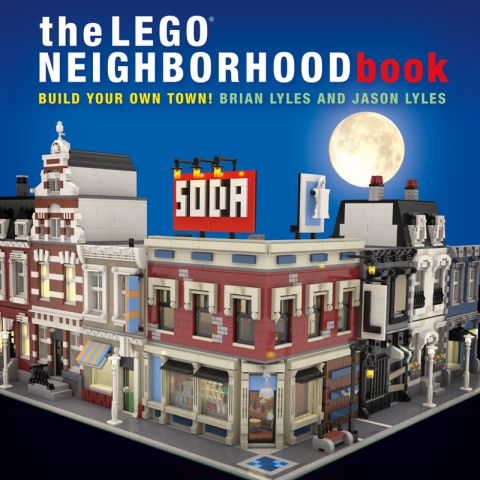
Briand and Jason, authors of The LEGO Neighborhood Book, aren’t newcomers to the LEGO hobby. In the introduction to the book they share how they played with LEGO while growing up and dreamed of becoming LEGO designers. Like most kids they put away their LEGO bricks when reaching their teens to pursue other interests, but they returned to the hobby as adults. And what really captured their imagination is the LEGO Modular Buildings, and the community of LEGO fans who tried to emulate and expand on the theme and style with their own compatible buildings. In fact, you may have ran across Brian and Jason’s website, BrickCityDepot.com where they share building instructions to their own custom LEGO creations that fit with the LEGO Modular Buildings line. The book is a natural expansion of this passion towards building realistic cities for minifigs.
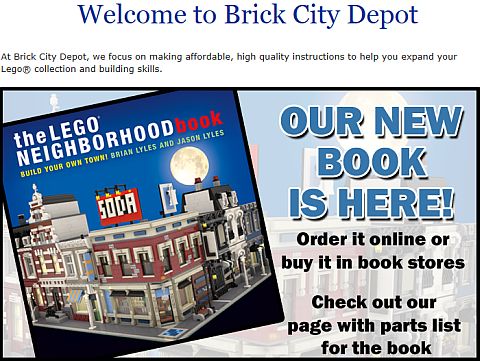
After the short introduction the book gets down to business to help you build your own LEGO buildings in the style of the LEGO Modulars. Each chapter covers an important aspect of learning how to build in this style; starting with learning the standard sizing and layout of the LEGO Modulars in Chapter, then in Chapter 2 you get some pointers on designing your own building – including choosing colors and styles by giving many pointers and real-life examples. (Here I should mention that the book is picture-heavy; each lesson is briefly described, then illustrated with photographs of real buildings and LEGO designs.)
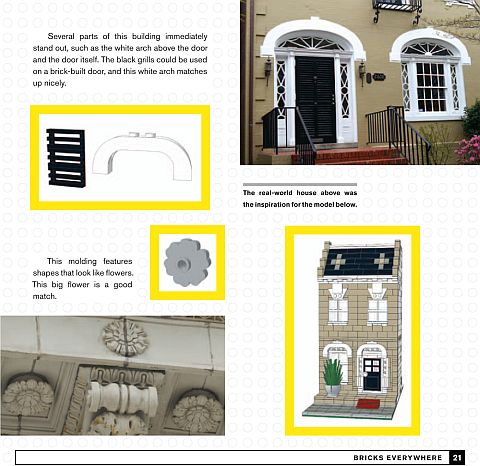
Chapter 3 continues with practical examples, but this time on the detailing; like how to build door and window frames, and how to mimic real-life examples of patterns, trims and mouldings found on buildings, taking advantage of the various unique shapes that you can find amongst LEGO elements. Columns, balconies and even wrought-iron work is also covered. And in Chapter 4 you learn how add final touches to buildings; things like turrets, railings, awnings, hand-rails, lights, decorative planters and more. The sidewalks are also covered with newspaper-racks, fire-hydrants, parking-meters, benches, traffic lights and so on. Most of these include step-by-step instructions to build your own, of very clear pictures so you can easily figure out how to build them.
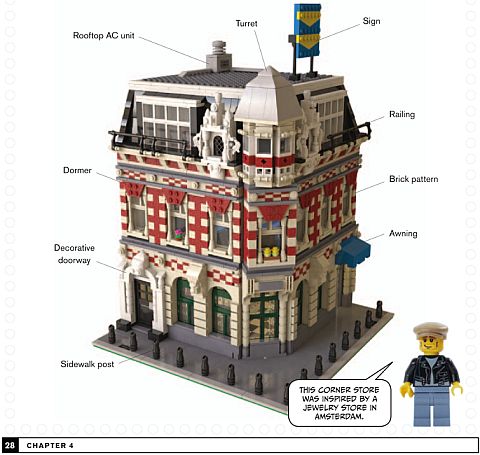
Chapter 5 covers the interior of buildings, giving you many ideas and step-by-step instructions to build your own interior decor. The chapter is broken down by rooms; living-room, kitchen, dining-room, bedroom, kids’ room, and bathroom. Each of sections comes with many excellent designs and ideas that you can use not just in LEGO Modular style buildings, but other LEGO building as well. Commercial building interiors are also briefly covered at the end of the chapter; a bank, a restaurant, a hotel and a jewelry store. Seriously; this is an excellent chapter with some really-really sweet designs any LEGO fan can learn from.
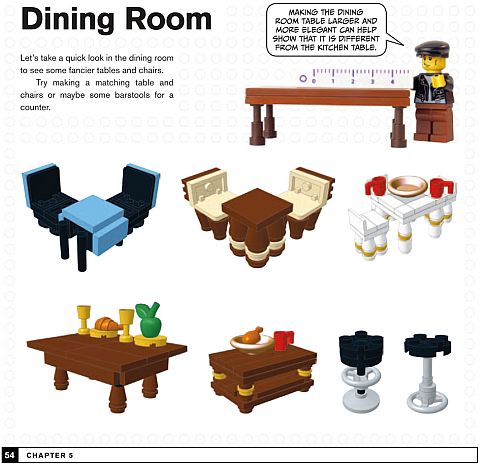
Chapter 6 is a gallery of LEGO Modular style buildings built by Brian and Jason. You can use these as inspirations for your own LEGO buildings. There are row houses, restaurants, shops, offices and more. My favorite is described as “an industrial building that has been repurposed as a coffee shop with a tech startup company upstairs” – I mean how much more real life could you get? 🙄
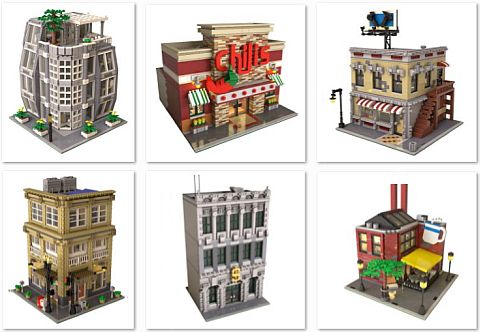
In Chapter 7 there are step-by-step instructions for one of Brian and Jason’s building, a LEGO Corner Drugstore. It includes a full parts-list and very-clear instructions for each building step similar in style to official LEGO building instructions. This is a pretty big and detailed set (like all LEGO Modulars), so the instructions continue for 60 pages.
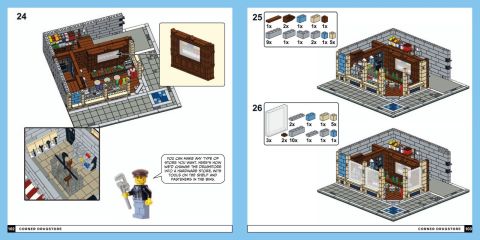
And now comes the last chapter which is actually my favorite, because I think the idea presented here is brilliant. In Chapter 8 you will get step-by-step instructions (and a list of parts needed) to build a basic residential two-story row-house on a 16×32 baseplate (so it is like the #10218 LEGO Modular Pet Shop which includes two buildings). However what you will end up here is just a base, not a finished building. The front will have lots of exposed studs that you can connect various facades to. Assembling the structural elements of your building separate from the decorative parts allows you to really experiment with new techniques without having to take the whole building apart each time. With the basic building complete, you will find instructions for three facades that will make the building look completely different; a Parisian Apartment, a Colonial Row House and a Canal Ring House (built in the style of Amsterdam’s Canal Ring district). Since the styling for each of these is only a facade, once you are done building them, you can easily customize them or even build your own facade. I can’t tell you how excited I am about this chapter; makes LEGO Modular Buildings so much easier to experiment with and build!
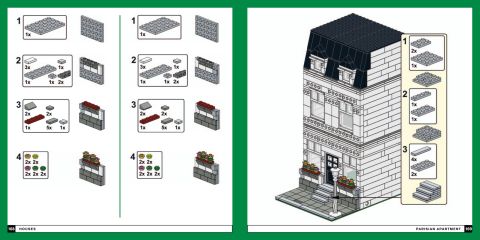
The LEGO Neighborhood Book is 200 pages in total and recommended for ages 10+. It is published by No Starch Press, which is known for their excellent LEGO books with easy-to-read text, brilliant pictures, and nice layout. I know as a reviewer I supposed to add plusses and minuses for a balanced review, but have absolutely nothing negative to say about this book. If you like the LEGO Modular Buildings and would like to get tips and tricks on how to build your own designs, I highly recommend it. If the LEGO Modulars are too big for your taste, and you prefer to build in regular LEGO City style, I still recommend the book for the lessons on detailing and the interior designs. Lots of great ideas there!
Here is the official description of The LEGO Neighborhood Book for your information: In The LEGO Neighborhood Book, you’ll create buildings with real-world details like cornices and facades, and try your hand at interior design by filling your buildings with furniture and light fixtures. Then add the finishing touches to your models with plants, traffic lights, scaffolding, and park benches. Snap together a few houses, shops, and apartment buildings to create your own neighborhood! Inside you’ll find: Complete, step-by-step instructions for four multistory buildings, dozens of inspiring ideas to use in your own models, mini builds for a recliner, old-time lamp post, traffic light, and more, and a gallery of the authors’ designs. The book is normally $19.99, and currently available on Amazon for a discounted price of $12.32 (this may change). Here is the link: BUY THE LEGO NEIGBORHOOD BOOK ON AMAZON
I hope this review helped you a bit to decide if this book is something that you would like to get. If you have the book already and would like to share your own opinion on it please feel free to do so in the comment section below. And if you have any questions or other thoughts about it of course you can share those too. 😉
And you might also like to check out the LEGO Books section for more reviews, or select from the following recent posts:












This indeed looks really interesting. Especially the last section. Might pick one up next time I shop on Amazon. How is the picture quality?
All the pictures (LEGO photos, real-life pictures, and building instruction steps) are very high quality. I have absolutely no complaints about any of them.
Hey Brickblogger,
I bought this book almost as soon as it was made available on Amazon. It’s really well done.
I have been collecting the Lego modular buildings, starting with the Fire Brigade. I wanted to build some of my own buildings to supplement my modular city. The nice thing about this book is that it starts with some simple guidelines on how wide, tall, etc., the building should be. For new MOC builders, this is very important. I understand that ‘artists’ don’t like to have boundaries in design. However, it’s really nice, when you’re learning to build in a new medium, to have some simple boundaries to build within.
I also like the numerous examples they give for the little details like benches, street lights, etc.
I got mine for $12 and change. Considering the content of the book, and the physical quality of the paper, etc., this is a very good value.
James
James, thanks for sharing your review. Yes, the basic guides are very important to understand the modular standard. And as you said, once that foundation is understood it is actually easier to get creative. 🙂
nice review!
and, guess what? i know some thing or to about that new leog mixels!!!!!!!!!!! watch this vid by lego, and you will see the mixels in it! (note: not all new or old mixels are there)
There’s no video linked. I have seen leaked images of the new mixels, however.
I have this on my Amazon wishlist and have looked at their creations on Brick City Depot. Very impressive, I know I’ll definitely need the help when I start getting in to the modulars.
Hm… $20. Not bad for the quality. I’m considering getting this, once I can afford it. I’ve never built a Modular building, and I have no Modular sets or City/Creator houses to speak of 🙁 , so it would be a neat experience. 🙂
Also, my brother got Captain America vs. Hydra yesterday, as a late birthday gift, and when he opened it the Captain’s head was not there! 😮 So I ordered a replacement one with some other parts today. 😕 Still, Captain Headless America… He could take after Shadow. 😕
Really? That’s odd. Particularly since I remember that in all official sets, the heads have always been distributed attached to the respective torsos.
No they haven’t. At least, not anymore. Every set I’ve gotten recently has had the minifig head separate from the torso, sometimes in a smaller bag even. 😕
Also, I was just at a clothing-toy exchange (also called mommy-baby, as that’s what it’s for), and whilst rummaging through the random assortment of junk, I came across… a Zane DX minifig! 😀 I also found a 1×6 light grey tile and some Bionicle chainsaw piece. I’m going to look them up to confirm their existence. Do the DX ninja have their names on the back of their torsos? 😕
Here are the Zane items available on BrickLink. Back names appear to be the case.
http://www.bricklink.com/catalogList.asp?q=Zane
Yes, the DX ninja indeeed has their name printed onthe back. Zane’s is with gold letters. 🙂
Thanks, @Håkan too. 🙂 But do you know anything about the chainsaw piece? All I know is it’s silver, has 3 peg holes and a 1-stud-length axle, and it’s Design ID is 44034. I don’t know how to search for it, but it doesn’t seem to be in a Bionicle set, as I scanned all of them last night. But it, and Zane DX, have ©LEGO on them. 😕
This?: http://www.bricklink.com/catalogItem.asp?P=44034
Yes, that’s it! Thanks very much! 😀 It seems that Brickset does not have it, though. 😕 But it is Bionicle, and Alpha Team, so mine comes from one of those sets.
It’s amazing that they made a part that only appeared in two sets. It doesn’t make any sense, but sometimes you run into this. LEGO is a strange company. 🙄
2002-2004. This seems to be around the “Jack Stone” crisis era, though, so it’s not that surprising…
The light gray tile seems fairly common, although it also seems like a part that’s easy to clone…
https://www.bricklink.com/catalogItemIn.asp?P=6636&colorID=9&in=A
https://www.bricklink.com/catalogItemIn.asp?P=6636&colorID=86&in=A
This insane part only appeared in one set, though…
http://www.bricklink.com/catalogItem.asp?P=87800pb01
Wow! Just wow! That is one complex design! And two colors! When I see parts like this I wonder what TLG was thinking. They always talk about how expensive it is to create new moulds. Then they make something like this and wonder how it got approved? 😕
My brother wants these sets or he will be so mad and sue the LEGO Company. ._. I was like wth you cant sue them .-. but I LOVE THESE SETS<3 Hope to be ON SELL soon ;-;
Great post! I’ll have to have a look at the book. I’m yet to get any modular sets, but they’re up there on my to do list! Any chance I can repost this on my blog?
John @ BricktasticBlog
John, yes, the book is especially great for modular fans. As far as reposting the article, I would suggest against it as your blog can be penalized for it. Besides, these are my thoughts, and you might end up having a different opinion. What I do when I find an interesting review is to write my own, then mention and link to the opinion of others in the article. 🙂